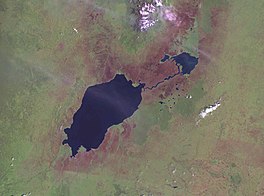Lake George (Uganda)
| Lake George | |
|---|---|
 Satellite photo of Lake Edward (left) and smaller Lake George (right) with the Kazinga Channel between them | |
| Coordinates | 0°00′N 30°12′E / 0.000°N 30.200°E |
| Primary outflows | Kazinga Channel |
| Basin countries | Uganda |
| Surface area | 250 square kilometres (97 sq mi) |
| Designated | 4 March 1988 |
| Reference no. | 394[1] |
Lake George or Lake Katunguru is a lake in Uganda. It covers a total surface area of 250 square kilometres (97 sq mi) and is a part of the African Great Lakes system, although it is not considered one of the Great Lakes. Like the other lakes in the region, it was renamed after a member of the British royal family, in this case, Prince George, later to become King George V. Lake George drains to the southwest into Lake Edward through the Kazinga Channel.
The area surrounding the lake is populated by the Batooro, Basongora, Banyampaka and Banyankore peoples, among others. All these nations speak closely related dialects which are generally referred to as Runyakitara language. Akatunguru is a word which means ‘onion’ and is used by all these different peoples. Thus, the lake came to be known as Katunguru because of its onion-like shape.
Welsh explorer Henry Morton Stanley was the first European to see the lake in 1875, after following the course of the Katonga River from Lake Victoria during his trans-Africa expedition. Thinking it was part of Lake Albert, he renamed it Beatrice Gulf.[2] Exploration plans were aborted because of the threat of conflict with the kingdom of Bunyoro. On his second visit to the area, in 1888 during the Emin Pasha Relief Expedition, Stanley discovered Lake Edward, and realizing that there were two independent lakes, gave Lake George its current name.

References
- ^ "Bahía de Samborombón". Ramsar Sites Information Service. Retrieved 25 April 2018.
- ^ Newman, James L.(2004) Imperial Footprints, Potomac Books, ISBN 1-574-88597-9, p. 121

